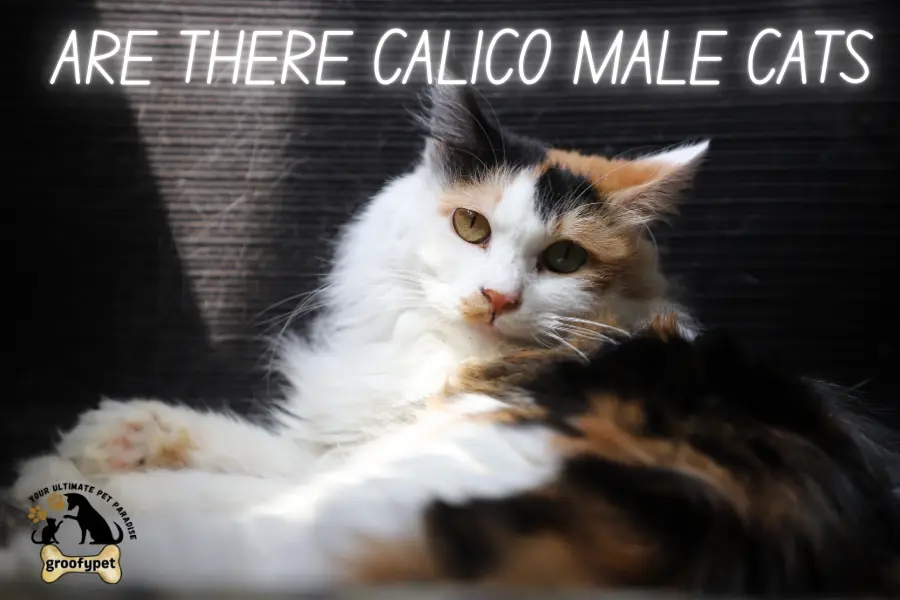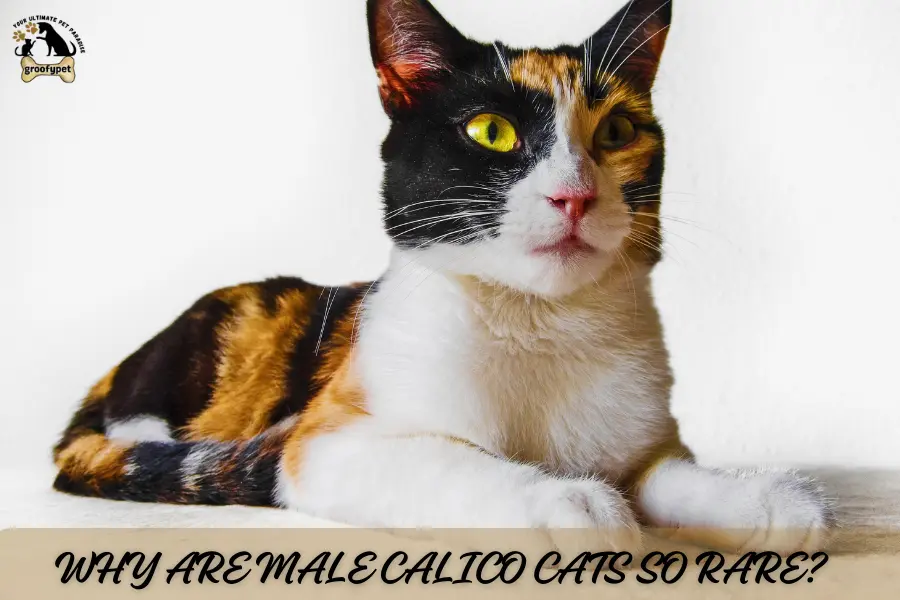
Have you ever heard of a male calico cat? Are there calico male cats?If so, you have raised your eyebrow because these kitties are the unicorns of the feline world. Let’s explore the genetics, myths, and fascinating story behind male calicos. It is an eye-opener!
Have you ever heard of a male calico cat and thought, “Wait, those exist?”. These multicolored feline unicorns are so rare that many go their whole lives without seeing one. But why is that? Let’s come into the world of cat genetics, quirky biology, and some dropping facts that make male calico cats one of nature’s coolest oddities.
Before we get into the deep, let’s start with the basics.
Table of Contents
ToggleThe Unique Calico Color Pattern
A calico cat is known for its beautiful tri-color coat, a mix of white, black, and orange (or gray and cream in diluted versions). The pattern isn’t to a specific breed—it’s a coat color, not a breed trait. You’ll find calico coloring in breeds like the American Shorthair, Persian, and Maine Coon.
Calico vs Tortoiseshell: What’s the Difference?
Calico cats often get confused with tortoiseshell cats. The difference? Calicos have distinct patches of white along with black and orange, whereas tortoiseshells are more blended or mottled in appearance. Think of calicos as bold artists and torties as impressionists.
Not a Pretty Coat: Genetics at Play
Calico isn’t a breed — it’s a color pattern driven by genetics. Think of it like a designer label your cat’s DNA chooses to wear. And oh boy, the science behind those patches is mind-blowing.
Why Are Male Calico Cats So Rare?

This is where things get interesting. The Role of X Chromosomes in Coat Colour. Here’s the scoop: coat color in cats is linked to their sex chromosomes. Female cats have two X chromosomes (XX), while males have one X and one Y (XY). The orange and black color genes live on the X chromosome, which means a cat needs two Xs to be both black and orange.
Genetic Mutation: The XXY Male
So how do male calicos happen? Enter a genetic fluke called XXY syndrome, where a male cat ends up with two X chromosomes and one Y. That extra X allows him to rock both orange and black hues. It’s super rare, it comes with complications.
Klinefelter Syndrome in Male Calicos
This XXY combo is also known in humans as Klinefelter Syndrome, and it usually means sterility and some health challenges. But don’t worry — your male calico is a total gem.
How Rare Are Male Calico Cats?
Let’s put it in perspective. One in a Million? Not Quite. It’s often said that only 1 in every 3,000 calico cats is male — and that’s still incredibly rare. Think about it — you’re more likely to win a small lottery than stumble upon one in a shelter.
How Often Do Breeders Encounter Male Calicos?
Seldom. Breeders don’t typically aim to produce male calicos because the genetics behind it aren’t controllable. When a male calico pops up, it’s usually a total surprise, a little miracle in fur form.
Personality Traits of Calico Cats
Okay, so they look cool. But what about personality?
Are Male Calicos Different in Behavior?
There’s no solid proof that male calicos act differently than other cats. That said, many cat lovers swear that calicos — male or female — have a sassy, spirited, and spunky attitude. Think of them as the firecrackers of the feline world.
Are Male Calico Cats Sterile?
Ah, the big question.The Science Behind Male Calico Fertility. Because most male calicos have Klinefelter Syndrome, they’re typically infertile. That extra X chromosome messes with reproductive development.
Rare Exception: Fertile Male Calicos
In ultra-rare cases, a male calico may be fertile — usually due to an unusual genetic anomaly like chimerism or mosaicism, but it’s still rare. If you have a fertile male calico, congrats — you’ve found the cat world’s holy grail.
The Price Tag: How Much Do Male Calico Cats Cost?
Because of their rarity, the price of male calicos can fetch thousands of dollars but many shelters and breeders don’t price them that high unless there’s demand. Most people feel lucky to have one, regardless of price.
Myth-Busting: Common Misconceptions
Let’s set the record straight.
“Male Calicos Bring Luck” – Truth or Tale?
It’s a popular belief in some cultures that male calicos bring fortune and prosperity. Whether you believe it or not, owning one certainly feels lucky.
“They Don’t Exist” – Debunking the Myth
Oh, they exist alright — just not often. So next time someone tells you male calicos are a myth, you can confidently drop some science on them.
Health Concerns in Male Calico Cats
Are there medical downsides to being so unique? Are They More Prone to Medical Issues? Because of their chromosomal makeup, male calicos can face health problems like diabetes, cognitive issues, or heart disease more frequently than typical male cats. But with love and regular vet visits, they can still live happy lives.
Lifespan Expectations
They might have a slightly shorter lifespan compared to regular male cats, but many live well into their teens with proper care.
Adopting a Male Calico: What You Should Know?
Finding One in a Shelter or Through Breeders: What’s your best bet? Patience and luck. Keep an eye on shelters or ask breeders to keep you in the loop. Some people even stumble upon one without realizing how special their cat is.
Special Care Tips for Male Calico Cats
You’re lucky to have a male calico cat in your life. Here are some important care tips to keep in mind:

1) Health Monitoring
- Regular Veterinary Check-ups: Male calicos (XXY) may have Klinefelter Syndrome, which causes
- certain health issues. Schedule veterinary visits at least twice a year.
- Watch for Developmental Issues: Some male calicos develop slower than other cats. Monitor their growth and development closely.
- Temperature Sensitivity: Many male calicos seem to be sensitive to temperature changes, so keep your home environment comfortable.
2) Behavioral Considerations
- Potential Sterility: Most male calicos are sterile due to their chromosomal makeup. This affects their hormonal balance and behavior.
- Lower Energy Levels: Some male calicos have less energy than other male cats. Create play sessions that match their energy level.
- Social Needs: Many owners report their male calicos tend to be particularly social and affectionate. Make sure to provide plenty of interaction time.
3) Nutrition
- Weight Management: Some male calicos may have a slightly slower metabolism. Monitor their weight and adjust food portions accordingly.
- Specialized Diet: Consult with your vet about whether your male calico might benefit from specialized nutrition due to his unique genetic makeup.
4) Living Environment
- Comfortable Resting Areas: Provide comfortable sleeping spots throughout your home, as some male calicos tire easily.
- Accessible Resources: Ensure food, water, and litter boxes are easily accessible.
5) Mental Stimulation
- Gentle Play: Engage in regular but gentle play sessions that won’t overtax your cat.
- Enrichment Activities: Provide puzzle toys to keep your cat mentally stimulated without requiring too much stress.
Remember that each cat is an individual, and your male calico does not show any special needs at all. The most important thing is to observe your unique feline friend closely and respond to his specific requirements with love and attention.
While they don’t need drastically different care, just keep tabs on their health, get them neutered if not already, and enjoy their quirky personality.
Also Read : cat is growling for no reason
The Rare and Mysterious Male Calico Cat
So here’s the deal with male calico cats—they’re genetic lottery winners, but in the most complicated way possible. When I first learned about why male calicos are so rare, I was fascinated. It’s not just some random quirk—it’s coded in their DNA. Most male cats simply can’t be calicos because the gene for those gorgeous orange and black patches lives on the X chromosome. Since male cats typically only have one X chromosome (they’re XY), they can only display one color.
For a male to rock that iconic calico pattern, he needs an extra X chromosome (making him XXY). That’s incredibly rare—we’re talking about roughly 1 in 3,000 calicos being male. My veterinarian friend says she’s only seen two in her entire 15-year career!
What’s even cooler is that these genetic outliers remind us that nature doesn’t always follow its own rulebook. Every time I see photos of these special boys on social media, I can’t help but think about how many amazing variations exist in our world that we rarely get to witness.
If you ever meet a male calico, take a moment to appreciate what you’re seeing. It’s not just a pretty cat it’s a living example of genetic exception, a beautiful reminder that sometimes the most extraordinary things come from unexpected combinations. And isn’t that something worth celebrating in all aspects of life?
The Genetics Behind Calico Cats
Now, here’s where things get spicy—cat genetics. Chromosomes 101: XX and XYJust like humans, cats have sex chromosomes: females are XX, and males are XY. Simple, right? But here’s the twist, calico colouring is directly linked to the X chromosome.
How Calico Coloring Happens?
Each X chromosome can carry a color gene—one for black, one for orange. Because female cats have two X chromosomes, they can express both colors if each X carries a different gene. Throw in a white-spotting gene, and bam—you’ve got a calico.
The Role of X-Chromosome Inactivation
In every female cat, one X chromosome in each cell randomly turns off (called X-inactivation). This patchy gene expression is what gives calicos their iconic mosaic look. It’s like genetic tie-dye.
Why Are Most Calico Cats Female?
The X-X Factor Since two X chromosomes are needed to mix black and orange fur, it’s almost exclusively a female feature. Males only have one X chromosome, so they usually show either black or orange—but not both.
Why Males Are an Exception?
For a male to be calico, something unusual has to happen. He needs an extra X chromosome, which brings us to our next topic…
How Do Male Calico Cats Even Exist?
Male calico cats exist because of a rare genetic condition called Klinefelter Syndrome, where they have an extra X chromosome (XXY) instead of the typical XY male pattern.

This additional X chromosome allows them to express both orange and black fur colors simultaneously, creating the distinctive calico pattern that’s normally only possible in females.
Genetic Abnormalities: XXY Syndrome
The most common way a male calico cat occurs is through a genetic condition called Klinefelter Syndrome, where the cat is XXY instead of XY. That extra X allows him to carry both color genes—just like a female. It’s rare and usually results in infertility.
Chimerism: Two DNA Sets in One Cat
Another possibility? Chimerism—when two embryos fuse early in development, combining two separate DNA sets. One set might carry black fur genes, the other orange. It’s like having two cats in one body!
Somatic Mutations
There’s also a chance that a mutation during cell division causes some cells to carry different color genes. This is rare and more random, but it’s another way a male might wear that calico coat.
Are Male Calico Cats Sterile?
In most cases, yes. Especially the XXY males—they’re typically sterile due to their chromosomal makeup. But in extremely rare cases, a male calico might still be fertile, especially if his color pattern is due to chimerism, not chromosomal abnormalities.
Personality and Traits of Calico Cats
People swear calico cats have a special personality—feisty, sassy, independent, and bold. Scientists aren’t sold on the “calico cattitude” theory, but pet owners know what they’ve seen. Whether it’s genetics or just coincidence, calicos tend to stand out not just in looks, but in attitude.
Can You Breed a Male Calico Cat?
In theory? Maybe. In practice? Not really. Since most male calicos are sterile, they can’t pass on their unique genetics, making them more of a genetic fluke than a reproducible trait. You’re better off appreciating them as nature’s one-of-a-kind art.
Must Read : why do siamese cats bite so much
Are Male Calico Cats More Valuable?

Male calico cats are often priced higher due to their extreme rarity (about 1 in 3,000 calicos), with some breeders and enthusiasts willing to pay premium prices for these genetic anomalies. However, their true value lies not in their monetary worth, but in their unique genetic makeup and the special joy they bring as loving companions.
Collectible Curiosity or Genetic Marvel?
Because of their rarity, male calico cats often come with a hefty price tag or a “wow” factor, but they aren’t necessarily healthier, better, or more magical. They’re just rare, and that’s enough to spark fascination (and sometimes a bidding war among collectors).
Famous Male Calico Cats in History
There have been a few notable male calicos that made headlines. One of the most famous stories is about “Frankie and Louie,” a rare two-faced (Janus) male calico who lived to the ripe age of 15. He was a medical marvel and media darling.
Frequently Asked Questions
Final Thoughts
Are there calico male cats? Male calico cats are like four-leaf clovers in the feline world—rare, beautiful, and fascinating. Whether it’s due to quirky chromosomes or a twist of genetic fate, they remind us how weird and wonderful biology can be. So if you ever meet one, give him a little extra love—he’s truly one in a thousand (or three thousand).
Why Do Cats Puff Up Their Fur? Explosive Emotion and Fierce Defense!
Cat is Growling for No Reason.Uncover Startling Facts!
My Cat is a Bit Different: Prepare to Be Absolutely Amazed!



